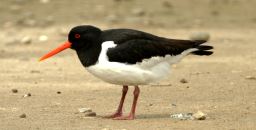High Tide 3.99m @ 09:11, Sunrise 07:59, Team meet time 06:00
Firstly, we wish to extend a special thanks to Stephen, and Phil of Teignbridge Council for allowing us to access the site, helping us set kit and for providing waders to team members who needed them. Thanks also go to Devon Wildlife Trust and the Warren Golf Club for allowing our continued access to the site and our project partners NE, UoE and GWCT for their ongoing support.
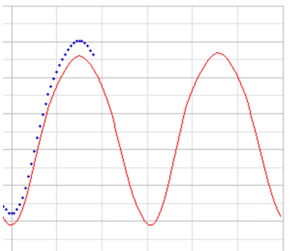 Tidal gauge data showing tide making over predictedAfter not being able to make a catch in September, the DCWRG committee were very keen to make a CN catch in October. Although the September attempt was cancelled a big thank you to Lizzie Grayshon (DCWRG CN-licence holder), Ryan Burrell (DCWRG Project Officer) and Tim Frayling (DCWRG Chair) for conducting 3 days of reccees during that high tide series to gain important information for the October catch dates. The main target for October were Oystercatchers to top up our colour-marked sample within the Exe estuary. Each autumn we aim to colour-mark 50 new Oystercatchers in the Exe. The long-term aim of the project being an important survival analysis for Exe oystercatchers, and comparing that to historic estimates, to explore the causes of decline. We started this project in February 2018 and we are generating some fantastic science with our collaborators.
Tidal gauge data showing tide making over predictedAfter not being able to make a catch in September, the DCWRG committee were very keen to make a CN catch in October. Although the September attempt was cancelled a big thank you to Lizzie Grayshon (DCWRG CN-licence holder), Ryan Burrell (DCWRG Project Officer) and Tim Frayling (DCWRG Chair) for conducting 3 days of reccees during that high tide series to gain important information for the October catch dates. The main target for October were Oystercatchers to top up our colour-marked sample within the Exe estuary. Each autumn we aim to colour-mark 50 new Oystercatchers in the Exe. The long-term aim of the project being an important survival analysis for Exe oystercatchers, and comparing that to historic estimates, to explore the causes of decline. We started this project in February 2018 and we are generating some fantastic science with our collaborators.
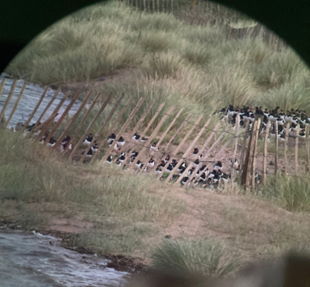 Oystercatchers roosting above the beachThe plan was set for a catch on the 27th October with nets set the night before. Unfortunately, you cannot plan for weather, so as fate would have it, a storm in the Atlantic played havoc with planning the catch. The tides were consistently going far over the predicted heights in the days running up to the catch with the dawn tide on the 26th going 45cm over its prediction and pushing 100 Oystercatchers well up in the dunes but they were in the right compartment where we have caught them before. There were 700 Oystercatchers and 200 Curlew also on the Warren spread between the point and the bay. This tide is one of the highest since we started operating on the estuary and the uncertainty in tide height made planning exactly where the birds will be very difficult. Along with these storm surges came inclement wind and rain so Lizzie as the catch leader made the decision to postpone the catch until Friday 28th. This was the perfect plan as the weather was predicted to be better, the rising tide would be later allowing us to fire ahead of tide and so accommodating the higher than predicted tide heights.
Oystercatchers roosting above the beachThe plan was set for a catch on the 27th October with nets set the night before. Unfortunately, you cannot plan for weather, so as fate would have it, a storm in the Atlantic played havoc with planning the catch. The tides were consistently going far over the predicted heights in the days running up to the catch with the dawn tide on the 26th going 45cm over its prediction and pushing 100 Oystercatchers well up in the dunes but they were in the right compartment where we have caught them before. There were 700 Oystercatchers and 200 Curlew also on the Warren spread between the point and the bay. This tide is one of the highest since we started operating on the estuary and the uncertainty in tide height made planning exactly where the birds will be very difficult. Along with these storm surges came inclement wind and rain so Lizzie as the catch leader made the decision to postpone the catch until Friday 28th. This was the perfect plan as the weather was predicted to be better, the rising tide would be later allowing us to fire ahead of tide and so accommodating the higher than predicted tide heights.
A small team met late on Thursday night to set the nets on the beach. This late set timing was to allow for nets to be set after the last high tide so there was no chance of nets getting wet during the unpredictable high tides. The weather was still unpredictable but based on the forecasted weather vs. its reality for the 2 dawn morning recess before, Ryan and Lizzie were confident we would get a suitable window for catching and processing. On the 28th, the team including DCWRG members, NE staff, UoE students and East Devon Council met and got into position after a briefing. The forecasted poor weather came through hours earlier as was hoped which made for a very pleasant wait. Unfortunately, the Oystercatchers did not play ball and about 100 birds had decided to roost in the next compartment along. A small flock of 30 Curlew were in the right compartment but too far along but we did have 8 Grey Plover beneath the nets. Grey Plover are normally very jumpy so we are confident the net was extremely well hidden so we are unsure of why the Oystercatcher behaviour changed. After some excellent twinkling from Lucy Hawkes, we flushed the pre-roosting Oystercatchers from the point but after a bit of flying around, unfortunately, unlike previous years they left the warren for a site on the Exmouth side of the estuary. We had previously been warned they might do this as Lee Collins (our DCWRG expert colour-ring reader) had noticed the Oystercatchers had started to do this after raptor disturbance during the past month. After our target species had left the estuary, Lizzie took the decision to fire on the remaining Grey Plover catching 3.
Although a much smaller catch than we are used to, the Oystercatchers did not see the net being fired and we colour-mark any Grey Plover we catch so the outcome is still positive. We know comparatively little about the habits of this species in the Exe as well as in British estuaries more generally. Also, they are less numerous and far more difficult to catch typically so although small it is a really useful catch.
A big thank you to the team for their efforts and a massive well done to Lizzie Grayshon as this was her first independent cannon-net catch after getting her cannon-net licence in September and during a very tricky period to catch in. The DCWRG committee look forward to Lizzie’s contribution to the group's future catches and wish to thank Robin Ward and Pete Potts for their roles in training Lizzie on previous DCWRG catches.
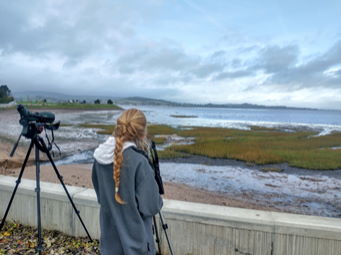 New DCWRG member Flo Turner resighting Oystercatchers with Ryan at Exmouth Rugby Club
New DCWRG member Flo Turner resighting Oystercatchers with Ryan at Exmouth Rugby Club 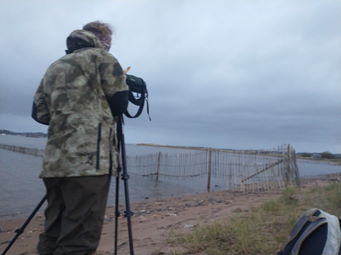 Lizzie Grayshon just about to call her first independent CN catch
Lizzie Grayshon just about to call her first independent CN catch
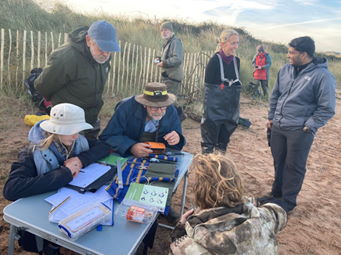 The processing team taking the time to teach new members about processing waders
The processing team taking the time to teach new members about processing waders 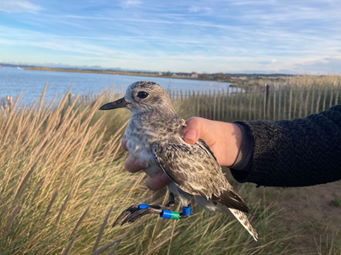 One of our newly colour-marked Grey Plover ready to be released
One of our newly colour-marked Grey Plover ready to be released
